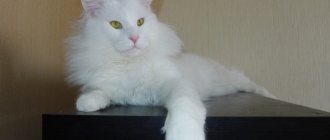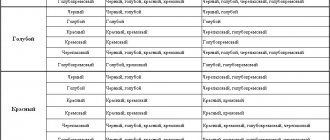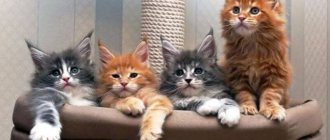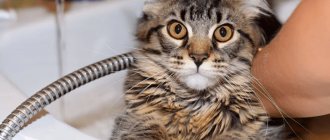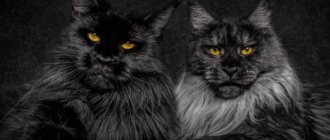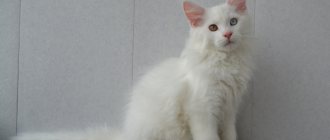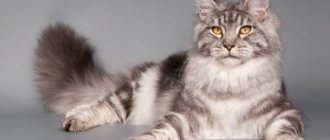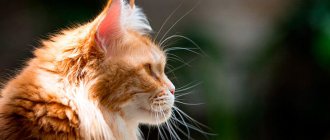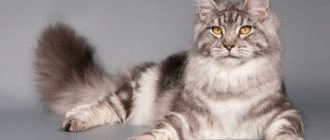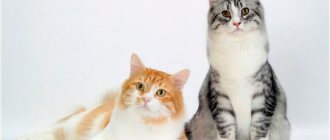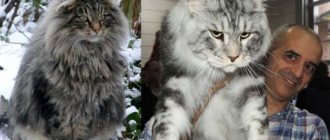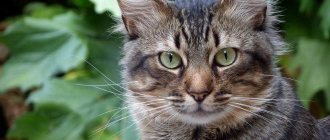Traditional Maine Coon colors: photos and descriptions
There are several types of coat patterns called tabby. They all have their own patterns. Tabby was inherited from the wild ancestors of modern domestic Maine Coons. Their distinctive feature is the letter “M”, which is visible in the area of the cat’s forehead and eyes with light or dark lines. There are three types of tabby:
- Tigers. The stripes on the body are parallel to each other.
- Spotted. There are spots of dark and light shades on the sides.
- Classic. Similar to the pattern of marble.
There is also a fourth type - ticked, but it is not typical for this breed. It is usually found in the Abyssinian breed and other oriental cats. It may appear in isolated coon individuals.
Often there are uniform colors in the same range; they are called solid or in the English version - solid (uniform). In this case, the tabby can be almost invisible. Often found in cats that are black in color. The darker the cat, the weaker the pattern of its coat appears. Tabby is especially pronounced in cats with fur of red (red) shades. Solids can be in the following palette:
- black;
- cream;
- red;
- smoky;
- blue.
Smoky gray and blue are of particular interest to Maine Coon breeders, as they are very rare for representatives of this breed. The gallery below shows photos of popular colors.
Maine Coon color calculator
To understand what color will result from crossing animals, breeders use a calculator table. With its help, you can predict with a very high probability what color the offspring of a thoroughbred couple will inherit.
How the coat colors of Maine Coon offspring interbreed.
This is, of course, not a guaranteed result, as it is impossible to calculate the exact genetic combination a kitten will inherit. From time to time, extremely interesting representatives of coons are born, having, for example, tortoiseshell tones, which is very rare for this breed. It has been noticed that most of these individuals are female.
Gray Maine Coon
Gray or blue colors are considered rare for this breed.
An even color of blue shades is a rare occurrence. A smoky shade is usually found. These cats look special; their color gives them their aristocratic charm. If a cat is exactly like this, it means that the gene responsible for the presence of a pattern on the body has been completely suppressed. Blue tones are specially developed through selective breeding. This takes a lot of time and effort from breeders. The letter “A” is placed in the passport of such a kuna. If the cat has two-color fur, the code “03” is added to the letter designation.
Tabby Maine Coon
Maine Coon colors are called tabby if there are stripes on the animal's coat. They are certainly present on the muzzle, circling the eye sockets and forming the letter M on the forehead. A careful examination reveals that the stripes alternate (light and dark). This combination is called agouti.
There are three main tabby patterns:
- Brindle . The strips are arranged parallel to each other in a vertical position;
- Classic . Stripes similar to marble stains are on the sides. They are wide and spiral;
- Spotted . The Maine Coon's body is covered with intermittent stripes in the form of spots.
Some experts also classify the Abyssinian pattern as a tabby. When there are no stripes or spots on the body, but there is a pattern on the face.
Tabbies come in a variety of colors, the color of the stripes and the tip of the tail being important. The hue of agouti, in turn, varies from pale blue to rich red.
Cost and where can I buy?
The price of a ginger kitten will depend on the color scheme. If the color is interesting and rare, the animal will cost more. Red Maine Coons are highly valued among breeders of this breed. The most expensive ones are red solid color, without a pattern. A silver and smoky Maine Coon will cost its owner 20 - 25 thousand rubles.
Even if the animal is not for exhibitions (the so-called pet class) but is of a rare color, its price will not fall less than 20 thousand rubles.
A red or cream tabby pet will cost less. A marbled cream or brindle red Maine Coon is estimated at 10-15 thousand rubles and more. White and red cats cost the same (if their color variations are not rare). The price of a kitten will decrease as it gets older. The most expensive animal is from 3 months. The older the Maine Coon, the lower its cost. Purebred Maine Coons from high-quality parents reach prices of up to 100 thousand rubles.
You can buy a kitten:
- Hand-picked at an exhibition, from breeders.
- In a local nursery (after finding it through an exhibition, on the Internet). You can choose from already born kittens or reserve a litter that is just expected.
- In a nursery abroad. The practice of ordering kittens from other cities and even countries is extremely common. If a future owner is looking for a purebred animal, he can order it from a specific breeder and from specific parents.
It is not recommended to take a kitten by hand, on the market, or via the Internet from unverified breeders. There is a high probability of mixed breeds and fake documents. Nurseries that raise Maine Coons very carefully monitor the fate and reproduction of all their pets. A purebred Maine Coon is a guarantee of breed standards, outstanding appearance and a flexible but independent disposition.
What types of Maine Coons are there?
Pedigree kittens have dozens of colors, but it is customary to distinguish several types, which will be discussed further.
Maine Coon color types:
- Solid colors or, more simply put, monochromatic. It includes: red, blue, black, white and cream.
- There is a very wide range of tabby colors. It refers to three main color options: spotted, marbled and brindle.
- Tortoiseshell.
- Silver or smoky.
- Bicolors. As we understand from the name, these are two colors.
Red Maine Coon
The red color refers to many types. Each of them deserves private attention.
© shutterstock
Red smoky color Maine Coon
A very interesting color, which is characterized in Maine Coons by dyeing the tip of the hair in an active color.
A Maine Coon cat with red smoke coloring is not very common. The hair at the base of these colors is white, and the tip is a rich shade. In our case, red.
This type of coloring in Maine Coons can be further divided into three types: standard smoke (1/2 hair colored red), shaded (1/4 red) and chinchilla (1/8 red). Naturally, the rarest type is the chinchilla. Buying such a kitten is very rare and lucky.
Red tabby Maine Coon
In this case, we are talking about ginger cats, so we highlight red marble. The red marble color of the Maine Coon cat is quite common and not rare. Accordingly, there are many Maine Coon kittens of this color on sale and at an affordable price.
The marbled color is characterized by smooth streaks over the entire area of the pet’s skin. In our case, the stains have a red pigment. The background is usually white or silver.
Solid red Maine Coon
In fact, a solid color is one-color, solid and without a pattern. But in the case of the Maine Coon, a primary color pattern without a bright, pronounced contrast is allowed.
A Maine Coon of red solid color without any signs of pattern is very rare. These kittens are worth their weight in gold . But the presence of a small pattern will not spoil the cat and will in no way affect its breed characteristics.
© shutterstock
The rarest and most expensive Maine Coon colors
Each breed has rare colors that are not often seen. Maine Coons are no exception. This breed has its own rare shades:
- Brown with spots. These kittens have a color similar to autumn foliage.
- Creamy blue. Looks like tortoiseshell with rare pastel shades.
- Chintz. This is a unique coloring for coons. The base is red, diluted with black tones with white splashes.
- Watered down chintz. There are cream-colored spots on a white background, and blue colors have a solid coloring.
- Spotted with white spots.
Such colors are not typical for coons and are rare.
Smoky
Such cats can be black or blue. The intensity of the haze determines the subspecies:
| Name | Description |
| Chinchilla | Only the tip of the hair is pigmented |
| Shaded | color has a quarter of the hair |
| Smoke | Only the root of the hair is colored white, the main part has black or blue pigments |
| True smoke | Half of the hair has pigmentation |
| Silver | the hair is white at the root, the rest is light silver |
| Cream | at birth, the coat is uniform in color, but gradually becomes unevenly pigmented |
| Classic wild | brindle, marbled black, spotted |
Smoky cats are characterized by white roots. Gray is usually found in monochromatic animals.
Chocolate
The wool is colored brown, warm, rich. The presence of inclusions of other shades or patterns is not allowed. The hairs have an even distribution of pigment. Unlike red tones, it is darker and deeper. Quite rare in breeding. The paw pads and nose also have brown tones.
Classic wild
This color suggests the presence of a pattern on the animal's fur. They can be of different types:
- brindle;
- marble black;
- spotted.
These are the main colors of coons that were common among their wild ancestors.
Peach
These cats have similar features to their cream counterparts. These can be yellow, orange shades characteristic of tabby coons.
Black
Black monochromatic coloring is extremely rare for this breed. Each black coon has a different color depth and saturation, so it is impossible to find two identical black cats. Usually, this color hides the pattern on the coat. In small kittens it can be difficult to see, but as they grow older it is completely hidden. The cat becomes completely monochrome. An animal with black fur looks regal, luxurious, reminiscent of a majestic panther in appearance.
Black and white
Cats with this coloration have different proportions of these colors:
- Black with white spots. There are several small spots of white on the fur.
- White medallion. A white spot is located on the chest of the animal, reminiscent of decoration.
- White gloves. The cat has black and only white paws of the animal.
- White tuxedo. There is a white shirtfront on the neck, and the paws are also white.
- Bicolor. Black and white in a 1/1 ratio.
- Harlequin. The color is predominantly white with a few black spots.
- Wang. The head and tail are painted black. The rest of the body is white.
What is the danger of white color
White Coons have a predisposition to complete deafness. It is found in this color much more often than in animals with a different shade of fur. However, there is no need to be upset by this fact. Deaf individuals feel great.
They live well in the house, and are oriented to the area no worse than healthy ones. Their hearing loss is compensated by vision and a keen sense of smell. People who do not know about cat deafness will not guess about it.
Cream
This shade is obtained by lightening the red. The animals are colored in shades similar to raw ginger. When crossing, individuals with genetically weakly expressed pigment in the pedigree are preferred. However, theoretically, even Black Solid Maine Coons can produce cream-colored offspring.
Maine Coon colors names with photos
The main genetic color variants of the breed are the Maine Coon with black fur and the pet with red fur. The color characteristics include information about the color of the fur, the type of pattern and the presence or absence of inclusions of other shades.
Black
Black is a rare color for Maine Coons. The pet's coat should be evenly colored, the tone should be even, the second name of the representative is Maine Coon of black solid color. According to the breed standard, only a small pattern is allowed, which is especially noticeable in bright light on a kitten. A pet with such fur should not stay in the sun for a long time, the fur coat will fade and its color will acquire a brown tint. The animal's eye color is copper or bright orange. Maine Coon black marble represents a cat with streaks on a black background.
White
The purest snowy coat of this coon is not colored with pigment; its absence makes the hairs white. The shade is fixed in the grown pet; such kittens are born gray or white with slightly noticeable cream stripes. With age, the color of the fur changes. The eyes are yellow or, less commonly, blue. Among animals with this color there are cats with eyes of different colors, the name of the feature is heterochromia. The white Maine Coon with blue eyes has a predisposition to deafness.
Ginger
The red Maine Coon, the classic version of the breed, wears a bright red coat, the color makes the cat look like a lynx. It is believed that representatives of this color are smarter and more savvy than other pets. The pattern is clearly visible on the sunny-colored wool. The Red Marble Maine Coon comes in a rich orange tone. The red Maine is in demand among buyers and cat lovers.
Blue
In a blue Maine Coon, the color from the roots of the hair can be gray or white. The shade of the coat is light or rich. Stripes, spots and tan marks are allowed in kittens; with age they become invisible. The Blue Solid Maine Coon is considered to have a uniformly colored coat; the presence of silver inclusions is not allowed. The eye color of representatives of the color is emerald and green.
Grey
Among the types of gray color, there are two options: cold and warm marble. Color is considered an indicator of the presence of black genes in Maine Coons.
Ticked
The forehead, chest and limbs of a ticked Maine Coon may be painted with a residual mottled pattern: a faint mark in the shape of the letter “M” on the forehead, circles or barely noticeable spots on the neck. The rest of the pet's surface is evenly covered with striped hairs. This color option is not so common among coons. At the root the pigment is more saturated, at the end of the hair it smoothly turns into a light tone. There is no clear pattern on the fur.
Tabby
Maine Coon Tabby is a type of coat that is drawn and is supposed to have stripes on its coat. The eyes of a representative of this color are outlined with a clear line, there are stripes on the muzzle and a slightly noticeable o. At close range, you can see the alternation of dark and light hairs on the coat, called agouti. Tabby colors come in the following varieties:
- classical;
- spotted;
- brindle;
- ticked.
The color can be shown by any of the pet's fur colors allowed by the breed standard. The shade is based on the tones of the stripes and the tip of the animal's tail. A variation of the tabby is also the chinchilla variant: 1/8 of the coat is dyed.
Tricolor
The tri-colored Maine Coon is a tortoiseshell variety that consists of cream, red, and black. Due to genetic predisposition, only females are born tri-colored; cats with this color are born very rarely. Tricolor cats are not considered a separate breed; this species arose accidentally, spontaneously. There is no historical information about the appearance of the fur variety.
Smoky
The roots of the smoky maincoon's hair are perfectly white. This is the main difference between the species and the blue pet. Varieties of smoky suit:
- black smoke;
- blue smoke;
- tortoiseshell.
The color saturation of 50% of the hair on the surface of an animal's fur is called “normal” smoke. The coloring of ¼ of the fur coat of a purebred animal has a name: “shaded” smoke. The color and location of the pattern fills 1/8 of the hairs, which means it is a Maine Coon Chinchilla.
Tortoiseshell
Pets with a tortoiseshell color are divided into two varieties: black and red, as well as bluish-cream. Particles of the presented shades on a colored coat are evenly scattered over the surface of the animal’s fur. It is believed that this color of fur occurs in cats. A male representative with this coloring appears rarely and cannot have offspring, as he has a feature: infertility.
There are varieties of tortoiseshell color: scaly and patchwork, as well as tortoiseshell tabby. There are variants of black wool with this type: torbi (a mixture of red and dark brown) and torti (red and cream). The tortoiseshell species can be presented in addition to white spots with clear, pronounced outlines.
Silver
A color is called silver if there are patterns on the smoky coat with a white root. Carriers of the color have emerald-colored eyes. Pets of the merle color on silver have peach-colored stripes on a light surface.
Chocolate
The chocolate shade of the Maine Coon's coat is not included in the classification of the breed standard. The first individual of this color, nicknamed Brownie, got the shade by accident. There are assumptions: her ancestors were Siamese cats.
Cream
The cream Maine Coon is considered a variety of red color. The pet has a delicate light shade of coffee with milk; spots and stripes are acceptable on the fur coat. A pure solid tone does not occur.
Marble
The type of color has a contrasting pattern: a combination of the main color with clear stripes and shapes. The following characteristics are acceptable for a marbled Maine Coon:
- clear round and oval shapes with obvious boundaries;
- large parallel wide lines along the body;
- butterfly pattern between the shoulder blades;
- the letter "M" on the pet's forehead.
brindle
Brindle coloring suggests the presence of vertical lines on the surface of the coat. Variegated blurry spots on the sides of the limbs complement the main pattern.
Spotted
The coat of the spotted Maine Coon is covered with fuzzy circles; this type has spots of different shapes and sizes in the form of intermittent stripes. Types of white spotted color:
- bath; a spot on the head and about three on the body;
- harlequin; there are markings on the back, legs and partly on the tail;
- bicolor, ½ blonde hairs.
Forest (wild)
Forest color - black marbled type. In appearance, a pet with such a fur coat resembles a wild cat. It is probably because of this color that the idea arose about the origin of the Maine Coon from the lynx and jungle cats.
How to understand color coding
To make it easier to identify a specific Maine Coon individual, tables have been compiled. They are composed as a coding, written in numbers and letters. This code system for identifying a white, black or red cat, as well as rarer colors (tabby, chocolate, tortoiseshell, tricolor) is called EMS.
To understand this encoding, it is enough to know which symbol means which color:
- N – black;
- A – blue solid;
- D – red Maine Coon (red kitten);
- F – Maine Coon tortoiseshell;
- W – white kitten;
- G – smoke or blue Maine Coon.
Additionally, if the Maine Coon is silver or silver merle, an extra "S" is added to the first letter.
A white Maine Coon with blue eyes will be identified not only by a letter, but also by a number. If such a cat has colored spots on the tail and in the shoulder area, next to the letter there will be “01”. If 50% of the coat is devoid of pigment, you will see “03” in the coding. If there is a small amount of white (on the paws and in the chest area) it is coded “09”. When designated "21" be aware that this type refers to the Maine Coon tabby color.
The number “25” denotes ticked color – this is one of the rarest varieties of such cats. Characterized by the absolute absence of tabby. However, each individual hair of such representatives of the breed has several colored stripes, thanks to which the Maine Coon cat looks very impressive.
Similar article: What to feed a kitten and an adult Bengal cat
Maine Coon color calculator
To facilitate the work of specialists evaluating show cats, a system for designating colors in Latin letters and numbers (EMS) has been developed.
According to this system, Maine Coon cats have the following colors:
- blue – a;
- red – d;
- brown – b;
- lilac – c;
- black – n;
- white – w;
- cream – e;
- silver (this also includes smoky) – s;
- tortoiseshell classic – f;
- tortoiseshell with a bluish tone – g;
- tortoiseshell with a brownish tone – h;
- tortoiseshell with lilac tone – j.
The numbers indicate the number of spots a cat has:
- 01 – white Maine Coons have only the head and tail decorated with spots;
- 02 – chaotic spots of different colors on the head, body, tail;
- 03 – bicolor cat, dark and luminous colors are approximately equal in area;
- 04 – large light spots;
- 09 – light spots in diameter do not exceed 2 cm;
- 11 – smoky shade, occupying 25% of the area;
- 21 – noticeable striping;
- 22 – marbling;
- 23 – brindle;
- 24 – spotting;
- 25 – ticking.
For example, the combination d22 means that the cat is red with a marble pattern.
The irises of Maine Coon cats come in several colors:
- 61 – blue;
- 62 – yellow, dark yellow;
- 63 – heterochromia;
- 64 – green.
Tortoiseshell
The tortoiseshell Maine Coon comes in two types – torby and torty.
The first type is a combination of red and black shades of wool, expressed in a dark brown color. The torti has a greater addition of red with dark cream. Of particular interest is the fact that tortoiseshell coloring is most often found in cats. The probability of a male being born with this coloring is approximately 1 in 1000.
On such cats, markings of different sizes and shapes are more clearly visible. Based on the severity of these spots, several colors can be distinguished:
- calico;
- flap;
- chintz.
These cats are characterized by the presence of red shades of fur. The classic color, consisting of three colors, is obtained by mixing black and red. This makes the coat more variegated. There are also several tortoiseshell shades.
Scaly tortoiseshell
Reminiscent of fish scales, the order of spots on the body is checkerboard. These spots alternate in black and red tones and are unevenly distributed. Any one of the colors may predominate.
Calico and solid tortoiseshell (patchwork)
The spots of black and red color resemble flaps. They have defined boundaries and can overlap each other. If the wool has white patches, this color is called “tortoiseshell white” or calico. Red and black spots are solid in color and clearly visible on the animal’s body.
Patterned tortoiseshell
Multi-colored spots have a pronounced pattern. These may be spots or stripes, but marbled colors are also common. There may be small white spots. In this case, it is fashionable to say that the color is spotted tabby or tabby with white spots.
Bicolor Maine Coon
Bicolor is very common among the colors of many breeds. Maine Coon was no exception.
This type of color is also called “with white”. That is, there are two main colors. In our case it is white and red. The ratio of these colors should ideally be 1:1.
Bicolor types:
- Harlequin - large red spots on white.
- The medallion is a white spot on the chest.
- Gloves - white paws are also called “socks”.
- Van is red only in his tail and head, everything else is snow-white.
- Buttons are small white spots throughout the fur.
- Tuxedo - socks and medallion contrast with the red.
Tortoiseshell Maine Coon
Tortoiseshell coloring can be either on its own or in combination with marble or tabby. The tortoiseshell coloration has spots of different sizes that are scattered throughout the Maine Coon's body. A Maine Coon with this coloration can have a variety of colors. Primary colors are usually black and red.
Spotted Maine Coon
The color palette of spotted Maine Coons is very extensive. The essence of the color is that there are broken lines throughout the cat’s body. Such lines form spots. Spotted colors can be combined with other types of colors. For example, with tiger or marble.
Brindle Maine Coon
The brindle color, like the spot, has stripes. Only the stripes are solid, without breaks. The color range is also wide. This type of coloring is not exceptional or rare.
With white spots (marks)
The presence of several or single white marks on the Maine Coon’s body, depending on their location, indicates that the color may be called:
- “One” are snow-white seals with colored areas on their head and tail.
- “Bicolor” is a two-tone color, half of the pet’s fur is always white.
- “Harlequin” - large snow-white spots on the pet’s body are arranged in such a way that they resemble the costume of a character from an Italian comedy.
- “White buttons” - several or just one small white spot.
- “Tuxedo” - white decor on the chest and paws of the pet.
- “White gloves” - the lower part of the paws is white.
- “Medallion” is one white spot on the animal’s chest.
White marks
Many Maine Coon fans try to breed kittens with touching white spots. This is explained not only by the fact that the markings on raccoon cats look spectacular, but also by the fact that some felinologists consider the absence of white in the color to be a real defect.
White spots on the Maine Coon's coat can be located on any color and be of completely different sizes, but they are always clearly visible, unlike Siamese cats, whose spots are shaded and do not have clear boundaries.
Maine Coons color tuxedo
Maine Coon kitten, harlequin color
Maine Coon with white socks
Maine Coon black and white To scientifically describe the color with a white spot, simply add “with white” to the main coat color, for example, black and white or red and white. People often call this color of a cat simply black and white or white with spots.
Color classification of Maine Coon with white spots
| Russian color name | English color name | Color characteristics |
| White gloves | mitted | the presence of white “slippers” on the paws |
| White medallion | locket | the presence of a white mark on the chest, which may resemble a tie, bow tie or even a collar |
| White buttons | buttons | the presence of one or more small spots that have a clear outline |
| Bicolor | bi-color | Maine Coon's coat is exactly half white |
| Harlequin | harlequin | the coat is completely white, except for a few large colored spots |
| Wang | van | the coat is completely white except for the head and tail |
| The tuxedo | tuxedo | a gentleman's set of a beautiful combination of white gloves and a white medallion on colored wool (this definition has not yet been officially recognized) |
Marble colors
Can be cold or warm tones. The first has more gray tones, while the warm one is dominated by brown shades. These stains sparkle in the sun in a special way, which many people like. Such stains can be drawn in different ways - stripes, spots, contours. Such spots can be well defined, then they are more reminiscent of a tortoiseshell color. Marble coloring has more diffuse, blurred borders of spots.
Single color
Solid colors of Maine Coons are called solid. They are bred by suppressing recessive tabby genes. In cases where the pattern cannot be completely suppressed, a shadow fuzzy tabby appears. When examining a black leopard, one can detect the outlines of the pattern, since suppressed genes are also present here. Red or cream colors are not able to suppress tabbies as effectively as possible; these representatives always have a pattern to a greater or lesser extent. To obtain a white monochromatic color, they act on a variety of genes that can completely suppress the color. Many white kittens initially have some vague shades of striping on their heads due to incomplete color suppression, but this usually goes away with age.
If a Maine Coon is black or blue, but has distinct white hair roots, then it is classified as smoke. Plain cats have greyish hair roots, while true smoky cats have only pure white hair roots. Smoky is one of the solid variants of silver tabbies. This is a very impressive and mysterious color. It is especially pleasant to watch such an animal when it moves, when the fur shimmers amazingly.
Maine Coons of blue color, as well as black (smoke) are divided into types based on hair color:
- Chinchillas – 1/8 of the hair is dyed. Shaded - 1/4 of the hair is colored. Smoky – 1/2 of the hair is dyed. Black smoke is black in color with white roots. Blue smoke - blue color with white roots. Silver (chinchilla, or shaded). Kittens appear white when born, but as they grow older they change color, becoming silver. White color can only be genetically obtained from white parents. Silvers sometimes have a tabby pattern at the tip, which disappears in the second month. A sure sign of a silver kitten is green eyes. Cream, red smoky or shaded color. White kittens are also born here, in which tipping appears over time.
Smoky colors
The smoky color is considered a solid variety of silver tabby. The color is also called smoky if each coat of a Maine Coon is white at the base, but black or blue at the tip. Only a cat with distinctly white roots can be called smoky - gray roots are characteristic of monochromatic animals.
Maine Coon black smoke
Maine Coon peach smoke
Maine Coon blue smoke
Maine Coon smoke is divided into several types depending on the length of the colored hair:
- Chinchilla - the predominant color on the coat is white, only the tips of the hairs are colored.
- Shaded smoke - only a quarter of the tip of the hair is colored.
- True smoke - the wool is half colored.
- Black smoke – black coat color and white roots.
- Blue smoke – blue coat color and white roots.
- Silver – light coat with white roots. You can distinguish such a cat from a white one by its eyes - in a silver cat they are always green.
- Cream (cameo) - kittens with this color are mostly born white, the topping becomes noticeable only over time.
Maine Coon black shaded smoke
Maine Coon Chinchilla It is quite difficult to accurately determine the type of smoky color, but in any case, this coloring of the whiskers always produces an impressive effect, especially when the cat plays or moves gracefully, shimmering light smoky colors on its fur.
Tabby
This type of coloring is present in all representatives of the Maine Coon breed, but may not be expressed in a bright form. This color is a genetic predisposition. A cat's hair has its own zoning or striping. The wild ancestors were tabbies, which was inherited by modern representatives. There are various options for this design.
Classic, spotted and brindle tabby
Characterized by wide stripes of a spiral shape. They are usually located on the sides of the animal, and can resemble marble stains. Spotted tabbies have intermittent stripes or spots of color throughout the animal's body. The brindle tabby is similar to the brindle coloring - vertical stripes along the entire length of the body.
Ticked Tabby
These cats have no stripes or spots at all. The fur has a peculiar pattern on the face, paws, and chest. Ticking is the distribution of pigment along the hair. The tip has a rich shade, gradually losing brightness towards its root.
Dangerous shining beauty
It is impossible to ignore such a serious health problem in white Maine Coons as deafness. This disease is traditionally inherited along with the W gene.
- About one in five white cats with eyes of any color are born deaf.
- In blue-eyed albinos this figure reaches a proportion of 4/5.
- If we compare white cats with different eyes, then 4 out of 10 animals have hearing problems.
Although scientists have not yet identified a separate gene for deafness, it has been proven that deaf parents consistently inherit this disease to their kittens.
Random color combination
Sometimes there are situations when the maine has a color that does not fit any of the color types. For this purpose, its own classification was created. These colors can be called:
- Brown tabby with spots. Such an animal has spots of red and brown.
- Blue spotted tabby. The cat in this case has cream and blue stripes on its body.
- Creamy blue. The spots are scattered in a chaotic manner throughout the body. This color is sometimes called a blue turtle.
- Creamy blue, white.
- Spotted tabby with white spots. The color is similar to the previous one, but there are inclusions of white spots.
Such combinations are also rare.
How would this be scientific?
The types of colors of Maine Coon cats in the unified international EMS system are assigned codes consisting of letters and numbers, each of which indicates a particular color characteristic:
- main color
| n | black |
| a | blue |
| d | red |
| e | cream |
| f | black turtle |
| g | blue cream turtle |
| s | silver or smoke (manifestation of one gene, but patterned individuals are called silver, and solid ones “smoky”) |
| w | white (may be due to the manifestation of different genes) |
- presence and type of white spots
| 01 | van (white individual with a small spot, spots of the main color) |
| 02 | harlequin (two thirds of the individual is white) |
| 03 | two-color or bicolor |
| 09 | with white (less than half white) |
- the presence of a pattern on the fur and its appearance
| 22 | marbled or classic tabby (“M” on the forehead and beautiful “butterflies” on the sides of the individual) |
| 23 | brindle tabby or mackerel (“M” on the forehead and stripes all over the body) |
| 24 | spotted (Maine Coons have torn tiger or merle) |
| 21 | agouti factor (recorded when it is clear that the animal is a tabby, but it is not clear what kind of pattern it is) |
| 11 | shaded (tabby on silver with a blurry pattern on the body) |
| 12 | chinchilla - black series of colors, cameo - red series (very strong silver, in which the animal looks almost white with a slight touch of the main tone, sometimes completely white) |
- eye color (not always indicated)
| 61 | blue - blue |
| 62 | yellow, golden - yellow, orange, golden, etc. |
| 63 | oddeyed - disagreement |
| 64 | green - green |
In terms of primary color, the following Maine Coon colors are allowed: black, white, red, blue, cream, cream-blue and tortoiseshell. Shades of chocolate and cinnamon are strictly prohibited for Maine Coons.
Features of individual breed types
Each type of Maine Coon breed has characteristic features. For example, tortoiseshell cats are born extremely rarely - in a ratio of 1:1000. Therefore, mystical traits are attributed to them. Such cats, as a rule, do not produce offspring. Tortoiseshell cats are more common.
Cats with white fur often suffer from deafness. This disease can be suspected even in kittens with white spots on their ears. To avoid obtaining such offspring, white cats should not be crossed with white cats. Light or bleached cats have finer hair than dark-haired cats.
Coons can have the usual diseases for cats, but, in general, they are a full-fledged healthy breed of beautiful, affectionate animals.
The Maine Coon breed is popular now. Many people undertake to breed kittens. To obtain purebred offspring, it is necessary to take into account all the features of the color and pattern of the parents of the future kittens. You need to know the features of crossing certain species. These are complex calculations, and not everyone can choose the right partner for a cat based on genetic parameters. To do this, you can use the breeder’s online resource. The calculator placed there will help solve the problem. The calculator is a table of species compatibility for obtaining a certain color and coat pattern in future kittens.
Tortoiseshell Maine Coon and tabby patterned
It often happens that the Maine Coon breed has completely random combinations of colors and shades. Then the color can be called:
- Tortoiseshell - spots of various colors and sizes are scattered all over the cat’s body, with the exception of white: black, red, cream;
- Tabby spotted brown is like falling leaves in the fall. Numerous areas of brown and red color on the Maine Coon's body. The color is also called torbie;
- Blue-cream . The body of the Maine Coon is covered with spots of pastel colors. They have blue and cream shades. This color is also called blue turtle;
- Blue spotted tabby . It is a delicate color with patches of blue and cream tabby.
Unrecognized
Chocolate, gold, and lilac colors are not allowed at specialized exhibitions. Coons with Siamese coat color are also not recognized. There are patterns that are considered unrecognized for the Coons. These can be called:
- faun;
- cinnamon;
- point;
- sorrel;
- acromelanic color.
The coat color of Maine Coons is distinguished by a huge variety of colors and their combinations. The eyes of purebred animals must match the color of their fur. They can be blue (only pure white wool), green, yellow. White individuals may have different colored eyes (blue and green).
Maine Coon smoke
If a Maine Coon cat is blue or black in color, but the roots of the hairs are white, it is called smoke. If the cats are monochromatic, their hair roots will be grayish. True smoky animals have white roots.
This Maine Coon color always smacks of mystery and is distinguished by its iridescent coat color.
In addition to blue and black smoke, you can also find the following varieties:
- Chinchillas - an eighth of the hair has color;
- Shaded – the hair is colored by a quarter;
- Silver – at birth, Maine Coon kittens appear white in color, but over time they acquire a shade of silver. A sure sign of such animals are green eyes;
- Cream, red smoky. At birth, Maine Coon kittens also have a white coat color, which changes with age.
Care
Red or cream Maine Coon require special care, if only because the condition of its coat (and therefore its beauty) directly depends on its health and living conditions. What you should pay attention to:
- He needs specialized food (for purebred cats, with a composition of 50% meat), feeding with natural products - fermented milk, vegetables, fruits, cereals, eggs.
- The red Maine Coon should be brushed 2-3 times a week, and daily during the molting period.
- Bathe no more often than once every two months with a special shampoo.
- Monitor the absence of lice, fleas, and other parasites.
- A kitten and even an adult animal require constant movement, they are active, love to play and run. This develops their musculoskeletal system, body, and nervous system.
- Love and affection contribute to the good appearance of the Maine Coon. Stress makes the fur dull.
EMS color code
The International Association of Felinologists has developed a table that includes color options recognized by professional breeders. We need such a systematic collection for the convenience of making entries in the pedigree of the animal, bringing information about the breed to a single standard.
Unified table of coat colors according to EMS coding.
Thus, all colors not included in the standard coding are considered coat color defects. Individuals with unrecognized colors are not allowed at exhibitions and are not used in breeding.
However, they are suitable for home keeping in the same way as those with coat colors included in the table. Representatives of this breed have many genetically determined color options. Each Maine Coon is beautiful in its own way, no matter what color nature gave it.
White - fortunately!
Relationships with white cats are generously described by folk wisdom in various signs and superstitions. In Russia, meeting and communicating with a white cat bodes well:
- A white cat is a welcome guest in the house of an unmarried girl. After meeting him, the woman will certainly get married soon.
- A white cat that appeared in the house during a woman’s pregnancy will become a reliable friend and amulet for the child.
- The girl will get married soon after she gives away 7 white kittens.
- Dreaming of a white cat means good news.
- Meeting a white cat on the street promises success in any endeavor.
The photo shows the cat Ostin from the Gray Claw`s cattery.
White Maine cats are amazing creatures. Communication with them brings joy and peace, allows you to better concentrate and make the right decisions. Photos with a colorful snow-white Maine Coon convey the charm of the pet and bring great aesthetic pleasure.
